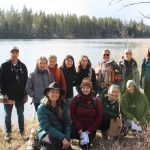Watershed Security in the Canadian Columbia Basin: Using Science to Inform Governance
Climate change is the most critical issue impacting water management in the Columbia River Basin, an important transboundary freshwater resource for agriculture, fisheries, power generation, First Nations and community users. Climate impacts are resulting in extreme temperature and precipitation, flooding, fire events and peak glacial melt. Water sources in the Columbia Basin are impacted with declining glaciers and snowpacks.
Existing water monitoring networks are insufficient to track and understand these impacts, which is why Living Lakes Canada is implementing a coordinated water monitoring network in the Canadian Columbia Basin using an innovative methodology developed by senior hydrologists, climate change and ecosystem experts.
The goal of the Columbia Basin Water Monitoring Framework is to establish a unified monitoring framework based on a Priority Monitoring Matrix that reflects both Indigenous and non-Indigenous local priorities within a scientific water balance approach. This collaborative approach will improve and strengthen a broader range of adaptation options in light of climate change impacts on the water supply for Basin ecosystems and its people.
Living Lakes Canada is piloting this project in three areas in the Canadian Columbia Basin. These pilot areas make up three of the 10 Hydrologic Regions (HRs) in the Basin: Mid-Columbia Kootenay (North Kootenay Lake/Slocan Valley, West Kootenay), Columbia-Kootenay Headwaters (Columbia Valley, East Kootenay), and the Upper Kootenay (Elk Valley, East Kootenay).
A Scientific Rationale for Expanded Monitoring
The critical issues of water resources management amid climate change impacts have been identified in the Canadian Columbia Basin going as far back as 2006 when the Pacific Climate Impacts Consortium (PCIC) published the report Preliminary Analysis of Climate Variability and Change in the Canadian Columbia River Basin: Focus on Water Resources. This report highlighted the need to balance documented climate impacts with monitoring of the region’s water resources and developing a collective effort to prepare communities and industry for change.
More reports followed: Climate Extremes in the Canadian Columbia Basin: A Preliminary Assessment published in 2013 by the PCIC predicted many of the climate change impacts currently being experienced in the Columbia Basin; Water Monitoring and Climate in the Upper Columbia Basin, Summary of Current Status and Opportunities published in 2017 by the Columbia Basin Trust (CBT) highlighted important water data gaps in the Upper Columbia Basin (UCB), a need for a coordinated monitoring effort, and a “streamlined archival and retrieval technologies” for water data.
Following the CBT report, Living Lakes Canada took action. A non-profit organization founded in the Columbia Basin with the mission to foster citizen-based water stewardship through science-driven community-based water monitoring, assessment and restoration programs, Living Lakes Canada co-convened a conference in late 2017 with the Gordon Foundation and WWF-Canada, bringing together 120 water data experts from across North America to discuss what a water monitoring framework and data hub would look like for the UCB.
Central Database for Water Data
Following the conference, Living Lakes Canada led the collaborative approach to determining the best solution for water data collection, analysis, sharing and storage, a multi-year process that culminated in the development of a database using a CKAN instance in early 2020.
Launched in March 2021, the Columbia Basin Water Hub is used by over 40 stewardship groups, municipal/regional/Indigenous governments, environmental professionals, and industry to share and access current and historical water data. Data can also be linked to existing databases that are openly available online. The Water Hub is also one of the hosts of the main database for Foreshore Integrated Management Planning data collected in partnership with the Department of Fisheries and Oceans.
Determining Priority Watersheds for Monitoring
To lay the groundwork for a Priority Monitoring Matrix, Living Lakes Canada convened a meeting in June 2020 of senior hydrologists from government, consultants and academia who reached consensus that a water balance approach was needed to fill the water data gaps in the UCB. That same month, the University of British Columbia published a 30-year study suggesting the glacier-melt contributions to runoff have already passed peak water for summer stream flows in the Canadian Columbia Basin.
Guided by these reports and proceedings, Living Lakes Canada contracted local experts to develop the Priority Monitoring Matrix methodology in 2021, outlined in Developing a Priority Matrix to Expand Water Monitoring in the Upper Canadian Columbia Basin: Steps for Pilot Implementation.
Implementation of this methodology began in early 2022. Local Reference Groups with broad cross-sector engagement were established in each of the three pilot areas. Hydrologic modelling and data gap analysis is being completed in the target/pilot, hydrologic regions. Local Reference Group participants will continue to identify key community concerns and priorities and this information will complement the scientific rationale for choosing which watersheds to monitor, given limited resources but substantive monitoring needs, and thus creating a complete Priority Monitoring Matrix to ensure that monitoring addresses both community and scientific needs in a nested, cost-effective manner.
Living Lakes Canada’s Applied Reconciliation Coordinator is working closely with Indigenous groups in the three pilot areas and throughout the Nations’ territories within and outside of the Columbia Basin to create meaningful engagement and to incorporate Indigenous water priorities in this project. To augment Indigenous knowledge and inform data gathering, MOUs have been signed with several Indigenous communities in the region outlining access and data sharing agreements.
Conclusions
The resulting data will facilitate future water budgets for eventual evidence-based water allocation required during water shortages. The data can also support the creation of community-centred, nature-based plans which address local ecosystem health, community priorities, Reconciliation with Indigenous Peoples, and climate adaptation while supporting local economies.
Current modelling suggests within 20 to 40 years low-to-no snow occurrences will become persistent in all mountain regions of western North America if greenhouse gas emissions continue as forecast, resulting in changes to water supply. This project will create the infrastructure to implement climate adaptation options at the community level, a necessary paradigm shift to collectively address water challenges imposed by climate impacts.
About Living Lakes Canada
Living Lakes Canada is an award-winning NGO that facilitates collaboration in monitoring, restoration, and policy development initiatives for the long-term protection of Canada’s lakes, rivers, wetlands and watersheds impacted by climate risk. Visit livinglakescanada.ca for more information.





